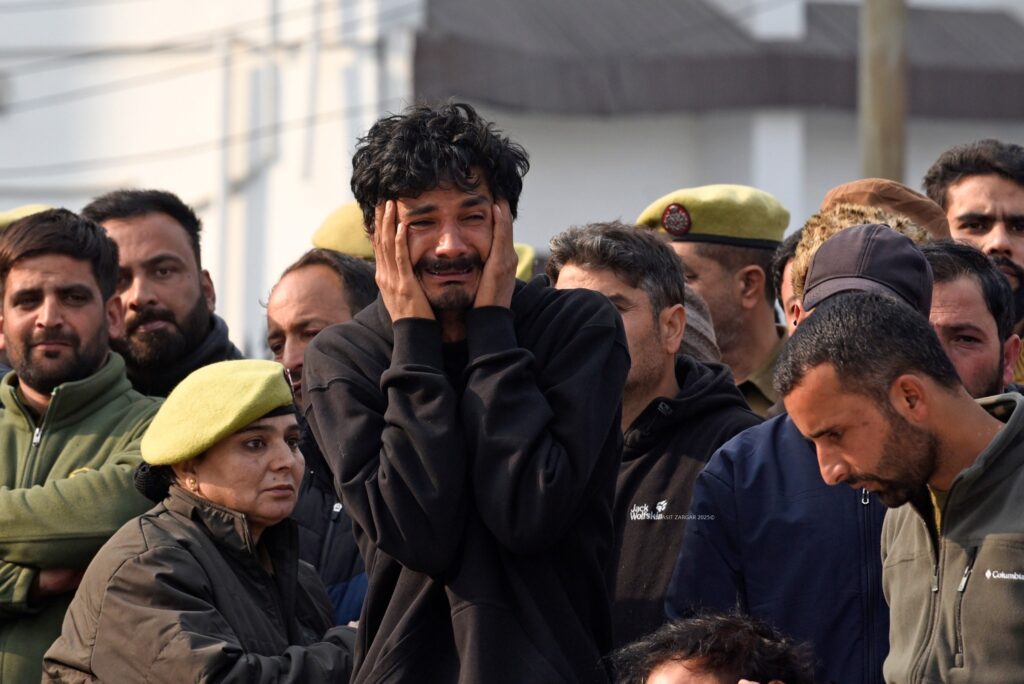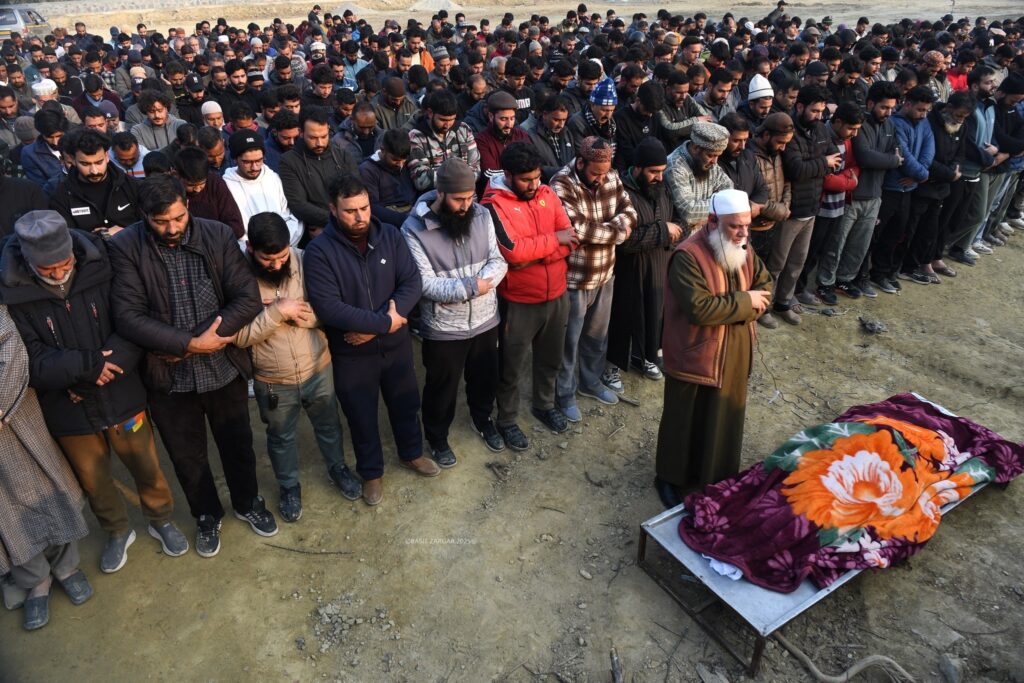As Delhi reels from a deadly VBIED blast near the Red Fort, a second tragedy unfolds in Srinagar’s Nowgam, where seized explosives detonate during forensic testing — deepening the mystery and widening the terror trail.
By Ajaz Rashid
The car bomb blast near Red Fort in Delhi on November 10, 2025, represents one of the most brazen and destructive terrorist attacks India has faced in recent years, orchestrated by a radicalized doctor-led terror module spanning multiple states. The audacity of the strike, its casualties, the massive investigative dragnet, and the shocking aftermath in Nowgam, Srinagar—where recovered explosives detonated—have gripped the nation and offered a sobering reminder of the anti-national forces threatening India’s unity and peace.
On the evening of 10 November 2025, a parked Hyundai i20 detonated near Delhi’s iconic Red Fort, turning a busy junction into a scene of horror. By the time the smoke cleared the death toll — reported variously as eight, a dozen and later as high as thirteen in different accounts as the investigation proceeded — and scores of wounded lay testament to a brazen act that Indian investigators now treat as a deliberate terrorist strike. The car blast jolted the capital, shattered a sense of security in a crowded public space, and set off an intensive inter-agency hunt for the perpetrators.
Within days that hunt reached into disparate places: lecture halls and clinics, quiet neighbourhoods, and the laboratories of a cross-border smuggling operation. Investigators say the explosive device was linked to an interstate “module” that had been under surveillance; the probe uncovered networks of recruiters and handlers, technical facilitators, and — chillingly — professionals whose credentials had cloaked their activities. In the same span, another catastrophe unfolded far from Delhi in Srinagar’s Nowgam: a cache of seized explosive materials, brought there as evidence in the Red Fort probe, detonated inside a police station during forensic examination and killed nine people and injured dozens. The twin tragedies — one an apparent terror attack in the national capital, the other an accidental detonation during an investigation — combined to underline both the evolving methods of modern terrorism and the risks of handling large quantities of unstable material.

This is the story of the attack, the arrests, the wider “white-collar” terror module that investigators say helped arm it, and the painful lesson of Nowgam — told from the perspective of a country determined to defend its people and institutions against those who would destroy innocent lives.
The blast near the Red Fort
Video footage and witness accounts show a white Hyundai i20 parked for hours near the Red Fort before a sudden, catastrophic detonation in early evening. The blast set adjacent cars on fire, shattered nearby shopfronts, and sent shock waves through a busy arterial area of the capital. Initially, casualty figures fluctuated as first responders worked through the rubble; by consecutive agency tallies the casualties numbered in the low-to-mid teens with many more injured and treated for blast-related trauma. Authorities rapidly declared the incident a terror act and handed the case to the National Investigation Agency (NIA).
Within days the NIA and Delhi Police announced arrests of people believed to have helped procure the vehicle and assisted the suspected suicide driver. The agency identified the man who drove the vehicle as Dr Umar Un Nabi, a medical college professor from Faridabad originally from Kashmir, and arrested associates, including Amir Rashid Ali, who allegedly owned the exploding car. NIA statements released during court proceedings say the agency has evidence of conspiracy and active links to a trans-state terror module.
Investigators are pursuing several leads: the chain that secured the vehicle, the origin and type of explosive used, whether foreign handlers provided technical instructions, and how a circle of recruiters attracted professionals to a militant cause. At least two associates with professional backgrounds have been detained as the probe widened, raising particular alarm for authorities: the possibility that ostensibly respectable social and professional networks were being exploited to plan mass-casualty attacks.
The “white-collar” terror module
What startled investigators most was the quality — and quantity — of material recovered during parallel raids in Haryana, Uttar Pradesh and Jammu & Kashmir. Police said they had seized enormous quantities of explosive precursors and bomb-making reagents — figures reported in media as running into the thousands of kilograms — and arrested multiple suspects, including doctors and other professionals. Authorities have characterised the group as a “white-collar terror ecosystem”: an array of radicalised individuals whose education, mobility and professional cover made them harder to detect.
Indian investigators say the module had links to established terrorist groups operating from across the border, principally Jaish-e-Mohammed (JeM) and Ansar Ghazwat-ul-Hind (AGuH). Both organisations are proscribed and have long used cross-border networks to recruit, radicalise and direct operations inside India. Officials say handlers overseas provided ideological direction and operational guidance while local facilitators provided logistics — vehicles, materials and technical know-how. The fusion of professional cover and extremist intent created a lethal new capability: attacks planned with the clinical precision of a workshop but with the murderous purpose of a terror cell.

Counterterror experts point out why this is especially dangerous. Professionals — doctors, engineers, academics — enjoy social trust and often access to resources and laboratories. Their movements and purchases can attract less scrutiny. When radicalised, their skill sets can be repurposed for designing devices, modifying delivery systems (drones, timed devices) or procuring dual-use chemicals. Indian agencies say disrupted plots suggested ambitions beyond a single bombing: reconnaissance, serial attacks, and even drone-delivered explosives modelled on tactics seen in other conflict zones.
The arrests
The NIA moved quickly to convert on-ground intelligence into arrests. Amir Rashid Ali — accused of conspiring to procure the vehicle used in the Red Fort blast — has been remanded to NIA custody amid allegations that he was the last person in contact with Dr Umar Nabi before the explosion. Additional arrests followed as the agency traced associates and facilitators across Kashmir, Haryana and other states; one of the later named suspects, Jasir Bilal Wani (aka Danish), was described by the NIA as an “active co-conspirator.” Court filings indicate the agency is building charges of conspiracy, murder, terrorism financing and arms-trafficking.
For the government and security agencies, those arrests are crucial for two reasons. First, they prevent immediate operational follow-on attacks by netting people who could be active participants. Second, remands give interrogators the time to map the network — communications, money flows, safe houses and foreign links — and to secure further evidence. Indian investigative practice in such cases has historically produced the operational diagrams that lead to additional arrests and interdictions; that process is now underway.
The tragic detonation of seized explosives in Nowgam
As investigators followed the trail of the Delhi blast back toward materials and facilitators, law enforcement agencies brought large seizures of explosives to Srinagar for forensic analysis. On 14 November 2025, in Nowgam on the outskirts of Srinagar, an explosive incident inside the Nowgam Police Station transformed an evidence-store into a site of disaster. Forensic teams working on the recovered stockpile were conducting examinations when a sudden and massive detonation occurred. Nine people — police officers, forensic experts, administrative staff and a civilian — were killed and dozens were wounded; survivors described a scene of fires, smaller secondary explosions, and devastation stretching across the compound. Authorities declared the detonation accidental.

The forensic trail
Terror-bomb investigations are painstaking. Forensic analysts read blast patterns and residue to identify the explosive type; traffic CCTV and mobile phone records establish movement; bank transfers and calls show funding and directions. In the Red Fort probe, the Hyundai’s registration records, CCTV footage, and cellphone metadata formed the first visible threads. The seizure of precursor chemicals and large volumes of explosive material in Haryana — quantities reported by investigators in the thousands of kilograms — provided the crucial link between those arrested in custody and the devices used in the attack. Forensic teams are cross-matching chemical signatures from remnants of the Delhi blast with samples recovered in raids.
Policy lessons and hard choices
The twin incidents expose several policy imperatives. First, traceability of explosive purchases and precursor chemicals needs tighter regulation and cross-border monitoring. Second, safe chain-of-custody protocols for seized materials must be standardised: transport in blast-hardened containers, examination at purpose-built, remote forensic facilities, and strict limits on quantities held in urban police stations. Nowgam’s victims demand such reforms. Third, the “white-collar” phenomenon requires outreach into professional communities: early-warning channels in universities and hospitals, awareness training for employers, and counter-radicalisation programmes that engage rather than simply surveil.
Finally, India must continue to pursue the transnational dimension: disrupting foreign handlers, choking off funding, and leveraging diplomatic pressure to deny terrorists safe havens.
Honouring victims by acting
The immediate response to these twin tragedies has been unmistakably Indian in character: frontline police and emergency crews rushing to help, hospitals taking in the wounded, communities opening their doors to grieving families, and the judiciary processing remand and charge sheets with procedural speed. At the same time the NIA’s arrests are a reminder that the rule of law, not vigilante reprisal, is the instrument best suited to dismantle terror networks and preserve civil order.

THE OFFICIAL STATEMENTS
National Investigation Agency (NIA)
- The NIA has taken over the investigation of the Red Fort area car bomb blast that occurred on November 10, 2025.
- They have arrested key accused including Amir Rashid Ali, the Kashmiri resident in whose name the Hyundai i20 car used in the blast was registered, and Jasir Bilal Wani, an active co-conspirator providing technical support.
- Evidence shows that the deceased driver and suicide bomber was Umar Un Nabi, an assistant professor from Faridabad.
- The NIA has seized multiple vehicles and explosives weighing around 3,000 kg as part of the probe and examined 73 witnesses so far, including injured persons.
- Investigators are pursuing multiple leads and working closely with Delhi Police, J&K Police, Haryana Police, and UP Police to dismantle the terror network.
- The agency has revealed the terror module involved was planning coordinated attacks using drones and remote-triggered explosives.
- The NIA has urged public vigilance and cooperation to prevent further incidents and ensure safety.
Delhi Police
- Following the blast, Delhi Police issued a public advisory urging citizens to stay vigilant and act as the eyes and ears of security forces.
- Enhanced patrols have been deployed in sensitive areas, with forensic squads conducting thorough checks near heritage sites and transport hubs.
- They have confirmed that the car blast near Red Fort was caused by a vehicle-borne improvised explosive device (VBIED).
- Police officials repeatedly urged citizens to report any suspicious activity promptly.
- Delhi Police is working hand-in-hand with the NIA and other agencies to investigate and arrest all involved.
Jammu and Kashmir Police
- The J&K Police and Lieutenant Governor Manoj Sinha have ruled out any terrorist angle in the Nowgam Police Station blast that killed nine personnel during forensic handling of seized explosives linked to the Delhi blast case.
- The accident occurred during sample collection and testing, and an inquiry has been ordered to establish the exact sequence of the explosion.
- J&K DGP Nalin Prabhat confirmed the blast was inadvertent and urged the public to avoid speculation.
- The Chief Minister Abdullah directed the Education and Health ministries to ensure medical care for the injured and compensation for damaged structures.
- J&K Police continues to assist in investigations related to terror modules operating across the region.
(With Inputs from various news organisations)

Leave a Reply